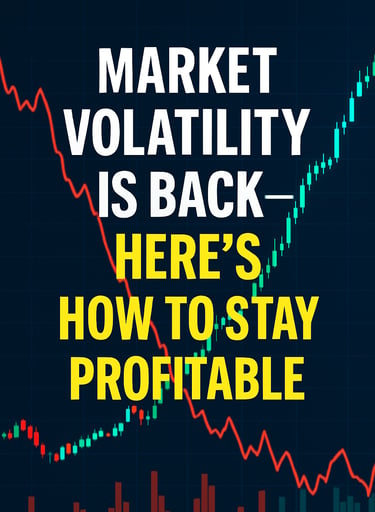Market Volatility Is Back—Here’s How to Stay Profitable
The stock market is once again on a rollercoaster ride. One day you’re up 3%, the next you’re down 5%. For new investors, it feels like chaos; for seasoned investors, it’s just another opportunity. But in times like these, your strategy—not your emotions—decides whether you make money or lose it.
RAVINDRA PRAJAPATI
8/8/20251 min read


Why Market Volatility Happens
Market volatility is not a villain—it’s a natural part of the financial cycle. It often spikes due to:
Economic uncertainty (inflation, interest rates, global trade tensions)
Geopolitical events (wars, elections, policy changes)
Market sentiment swings driven by fear or hype
Think of volatility as waves in the ocean. You can’t stop them, but you can learn to surf them.
Rule #1: Have a Clear Plan Before You Invest
When the market swings wildly, panic selling is the biggest wealth killer. If you have a pre-defined strategy:
You know your entry and exit points
You stick to your risk tolerance
You avoid impulsive trades
Pro Tip: Use a diversified portfolio to absorb shocks without wiping out gains.
Rule #2: Focus on Quality, Not Noise
During volatile times, speculative stocks often crash hardest. Instead:
Stick to companies with strong fundamentals
Look for consistent cash flow and low debt
Avoid following “hot tips” from social media without research
Rule #3: Think Long-Term
Short-term volatility means nothing if you’re investing for 5–10 years. The biggest market gains often come right after the worst crashes. If you stay invested:
You capture the recovery rallies
You avoid the regret of selling too early
Rule #4: Keep Cash Ready for Opportunities
When the market drops, high-quality assets go on sale. Having some liquidity means you can buy more at lower prices—turning volatility into profit.
NOTE : Volatility is a double-edged sword—it can slice your portfolio or sharpen your returns. The key is to stay calm, stay invested, and see the dips as buying opportunities rather than threats.
In short: Volatility rewards the prepared, not the panicked.
RAVINDRA PRAJAPATI, Not a sebi registered
FOLLOW Us
ravindra.prajapati1122@gmail.com
+91 9795187745
© 2025. PiPiFinTech All rights reserved.
Contact Us
ABOUT Us
Our mission is to empower you to maximize every single penny and best solution for wealth generation and management for every mature age group.
Product TOPICS
Digital E-Wealth Platform
Mutual Funds
Education Planning
Insurance
FD and Bonds
Retirement Planning
Wealth Creation
(Disclaimers : Mutual Fund investments are subject to market risks, please read scheme related documents carefully.)
